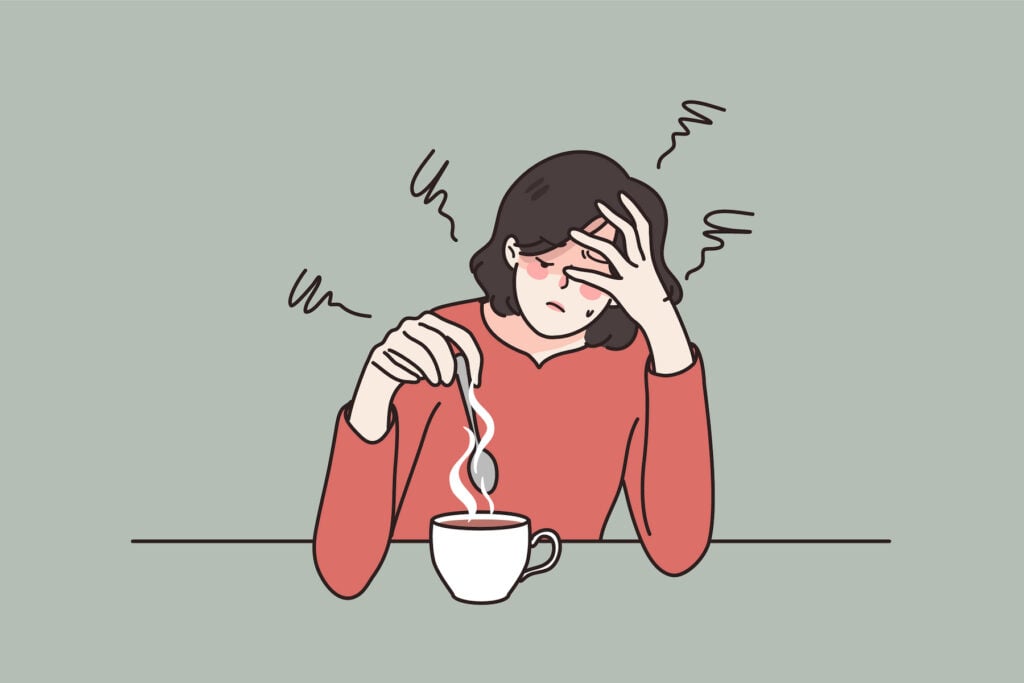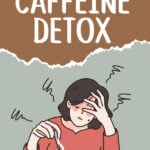Caffeine Detox: Why + how to take a break from caffeine
Does it seem like your morning cup of coffee has turned into not only an AM pour, but also an early afternoon pick me up and evening jolt? Has what once was a morning treat, now become a staple for starting and enduring your day?
It’s easy to lean on coffee, tea, soda or energy drinks to make up for your severe lack of sleep or energy. It’s something that you can grab and go. But for some of us, caffeine is more than an energy booster, it’s our lifeblood.

In North America, 80% to 90% of all adults use caffeine regularly. (source) The mean daily intake in the United States is 280 mg, which is equal to about one or two mugs of coffee or three to five soft drinks.
Tallying up your daily total? If it’s higher than the average, you should probably keep reading.
What Is Caffeine?
Before we dive into the reasons why you might want to cut back on caffeine, let’s take a quick minute to understand what it is in the first place. Caffeine is a white, bitter substance that’s found naturally in over 60 plants. These plants include coffee beans, tea leaves and cacao pods. Simply, it’s a stimulant that can help increase energy. And according to the The U.S. Food and Drug Administration (FDA), caffeine is considered to be both a food additive and a drug.
You can feel increased energy as soon as 15 minutes after drinking or eating a caffeinated product. The level of caffeine in your blood peaks about one hour later and it will stay at this level for several hours. After about six hours, half of it is still in your body. It can take up to 10 hours to completely clear caffeine from your bloodstream.
Why People Take a Break from Caffeine
If you are hoping to become pregnant, you may want to prepare your body with the help of caffeine cleanse. The American College of Obstetricians and Gynecologists cautions pregnant women to limit caffeine to 200 milligrams daily. That’s about one small cup.
But pregnancy is not the only reason to consider doing a caffeine detox. Caffeine affects mood and alertness, blood pressure and heart function, respiratory and kidney function, the immune system, gut health, and sleep cycles.
Here are some signs that you may be in need of a caffeine cleanse:
- You drink coffee out of habit and no longer feel increased energy after multiple cups. Many people develop a tolerance for caffeine, so you might find that you must keep increasing your caffeine intake to achieve that same boost you used to get with one cup.
- You’re experiencing more anxiety, irritability, or difficulty concentrating than usual. Caffeine can increase your heart rate and in turn exasperate anxiety symptoms.
- You’re having trouble falling asleep. Caffeine stays in your bloodstream for up to 10 hours. If you drink too much coffee and late into the day, it can disrupt your normal sleep patterns.
- You are extremely sluggish without caffeine. It’s easy to joke about caffeine being your blood type, but you really shouldn’t rely on any substance to the degree that you need it in order to function at a basic level.
- You’re having stomach issues. Caffeine causes the release of acid in the stomach, which may lead to heartburn or indigestion symptoms.
Health and nutrition experts agree that consuming more than 600 mg of caffeine a day (equivalent of four to seven cups of coffee) is too much. If you’re sitting in that category, or just want to give your body a break, here’s how.
How to Detox from Caffeine
A caffeine detox is not something you should jump into without proper preparation. Going cold turkey can result in headaches, migraines, trouble sleeping, brain fog, fatigue, and just miserableness overall.
Here’s how to caffeine detox the right way and with minimal symptoms of caffeine withdrawal:
- Keep a caffeine journal pre-detox. It’s important to really understand how much caffeine you regularly consume before you start cutting back. Cutting back too much, too soon can onset negative withdrawal symptoms.
- Try switching to half-decaf, half-regular. About a week before your caffeine cleanse, start cutting down by doing a blend of half-decaf and regular. If you are handling the decrease well, continue to wean yourself off by adding a little more decaf and a little less regular each day.
- Gradually cut back the amount of overall caffeine you consume per day. Is coffee not your only caffeinated beverage? Start cutting down on other drinks, including soda, tea and energy drinks, too. Just remember, don’t go from three sodas a day to zero. Gradually cut down day-by-day for a week or two before your detox.
- Create new distractions or ways to energize. Come up with a few things you can do to satisfy a need for an energy fix. Try 5 minutes of deep breathing, stretch, or go for a walk. If you’re home, even a quick cold shower could help increase energy and alertness.
You can do your cleanse for as long as you like, but many think that starting with one week is good way to reset. Once you detox for the first time, future detoxes shouldn’t be as challenging.
Caffeine Cleanse Tips
Addressing withdrawal symptoms with caffeine is one of the most common reasons why people fail. Keep these tips in mind if you experience withdrawal or find yourself struggling to commit.
- Drink something warm. Sometimes, it’s the habit that we’re hooked to and not the actual caffeine. You can continue to drink decaf coffee, caffeine-free teas, and flavored sparkling waters to help appease any tendencies or habits. Be sure to choose loose leaf tea or tea bags that don’t contain microplastics.
- Drink water. When the urge for your daily dose hits, drink water. Hydrating is always a good idea and you’ll start to identify how often you really reach for a pick me up. Add lemon or cucumber to water to change up the taste.
- Boost your magnesium. Caffeine depletes magnesium, which facilitates more than 300 processes in the body. Low magnesium levels lead to insomnia, headaches, muscle soreness, brain fog, and more. Modern farming has made our soils mineral-deficient and fluoride binds to magnesium in water. So, the traditional ways of getting enough minerals aren’t very effective. Topical magnesium spray doesn’t have to pass through the digestive system and can enter the blood and tissues more quickly than a supplement.
- Make sure your nervous system is regulated. Caffeine stimulates the central nervous system and turns on dopamine signaling in the brain. Without this regular adrenaline rush, your nerves may feel jangled or dysregulated. These simple CNS healing tips are a big help – mentally and physically.
- Keep a homeopathic pain reliever on hand. A really bad headache may tempt you to go back to coffee or soda for some relief, but this starts the dependency cycle all over again. Avoid pain meds with caffeine and instead try an all natural option. Stock up ahead of time, so it’s easy to access if you need it.
- Try a cold therapy head wrap. These headache ice caps can work wonders when you’re experiencing a migraine or pounding head pain. Again, get one before you begin your detox, so you have it ready if you need it.
- Use a diffuser with invigorating scents. Some essential oils including, peppermint, orange, spearmint, rosemary and lemon are known for their energizing and mood boosting properties. Keep a diffuser running to help stimulate your body through other senses.
What To Do After a Caffeine Detox
Maybe you’ve decided to stay off of caffeine for good. But a cleanse doesn’t mean you have to forgo coffee forever. That said, you should try to add it back into your routine slowly.
Another option is the 80/20 rule where 80% of the time you abstain from caffeine but let yourself have it 20% of the time. With this approach your caffeine consumption will be significantly lower than before your caffeine detox.
Is Normal Coffee Toxic?
Conventionally grown coffee is known to be one of the most chemically-treated beverages available. That’s because some producers over roast their beans at extremely high temperatures.
Doing so can result in dangerous roasting byproducts like HCAs and acrylamide. Not to mention that the beans are grown using large amounts of chemical fertilizers and pesticides to begin with.
Is Organic Coffee Better?
For starters, organic coffee is grown without harmful pesticides. This makes it a better choice for you—and the environment. One way organic coffee is grown is by using “shade trees” to naturally protect coffee plants from overexposure to sunlight. This process allows for the beans to grow in nutrient-rich soil sans pesticides, so you get a higher quality bean.
Specialty-grade coffee takes it a step further. On top of being pesticide-free, it is also tested for mold and mycotoxins. Plus, it will be roasted in a smokeless machine to reduce dangerous byproducts like acrylamide.
What To Do About Creamers
And if you’re looking for a healthier cup of coffee all around, you’ll also want to take a look at your creamer options.
Many flavored store-bought creamers have chemicals and artificial flavors added. Instead, consider adding organic or raw milk or try this Homemade Almond Milk and Creamer recipe.
Long Term Caffeine Alternatives
If you want to stay away from coffee and soda for good, you may still want to caffeinate in other ways. Green tea is one great option and so is matcha. Matcha naturally contains caffeine. Regular green tea contains about 28 milligrams of caffeine per eight-ounce cup Matcha contains more because you actually drink the tea leaves.
Golden turmeric milk is another great alternative. It is packed with nutrients and antioxidants. Turmeric can help reduce inflammation in the body, aids in digestion and reduces bloating. Plus it can help improve liver function, boosts the immune system and supports brain health. How’s that for a boost?

